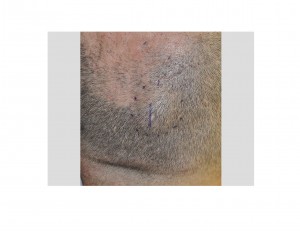Background:It is not uncommon for someone to have a small ‘lump or bump’ on their head. There are numerous things that it can be with the most common being a scalp cyst from the skin or hair follicles or a growth on the bony skull. Skull growths are usually benign bony tumors referred to as osteomas. While such bony tumors can be quite large and can be found on the inside of the skull, I am referring specifically to those small growths on the outside of the skull that are both painless and benign.
External skull osteomas are often quite small, less than the size of a dime, and their presence is of no aesthetic consequence. But when they get larger, raising up more off of the skull’s surface, they become visibly noticeable. This is particularly true in those that appear on the forehead and in men with thinning or no hair anywhere else on the skull. For those people who have them of some size, they often feel like they have small horns growing out of their skull
Most of these hard skull bumps can be diagnosed by feel alone. But when they are larger should be evaluated by x-ray before removal with a non-contrast CT scan being the test of choice. The purpose of this test is to be sure that the bony growth is limited to the outer surface of the skull and does not represent expansion and thinning of the inner surface of the skull.



Case Highlights:
1) Lumps and bumps on the skull, known as osteomas, are benign growths on the outer cranial surface. They cause visible uprisings of the scalp that can become particularly visible in men with close cropped hairstyles or advanced stages of balding.
2) Skull bumps can be easily reduced by burring reduction or osteotome removal. The biggest consideration in their removal is the surgical access or incision.
3) Unless on the forehead, skull bumps or osteomas can be reduced directly by small incisions placed partially over them. They heal with minimal scarring even in men. On the forehead they can usually be reduced through an endoscopic approach in women but there may be no advantage to doing so in some men based on their hair pattern and density. This minor form of skull contouring or reshaping for unwanted lumps and bumps is both simple and very effective.
Dr. Barry Eppley
Indianapolis, Indiana


